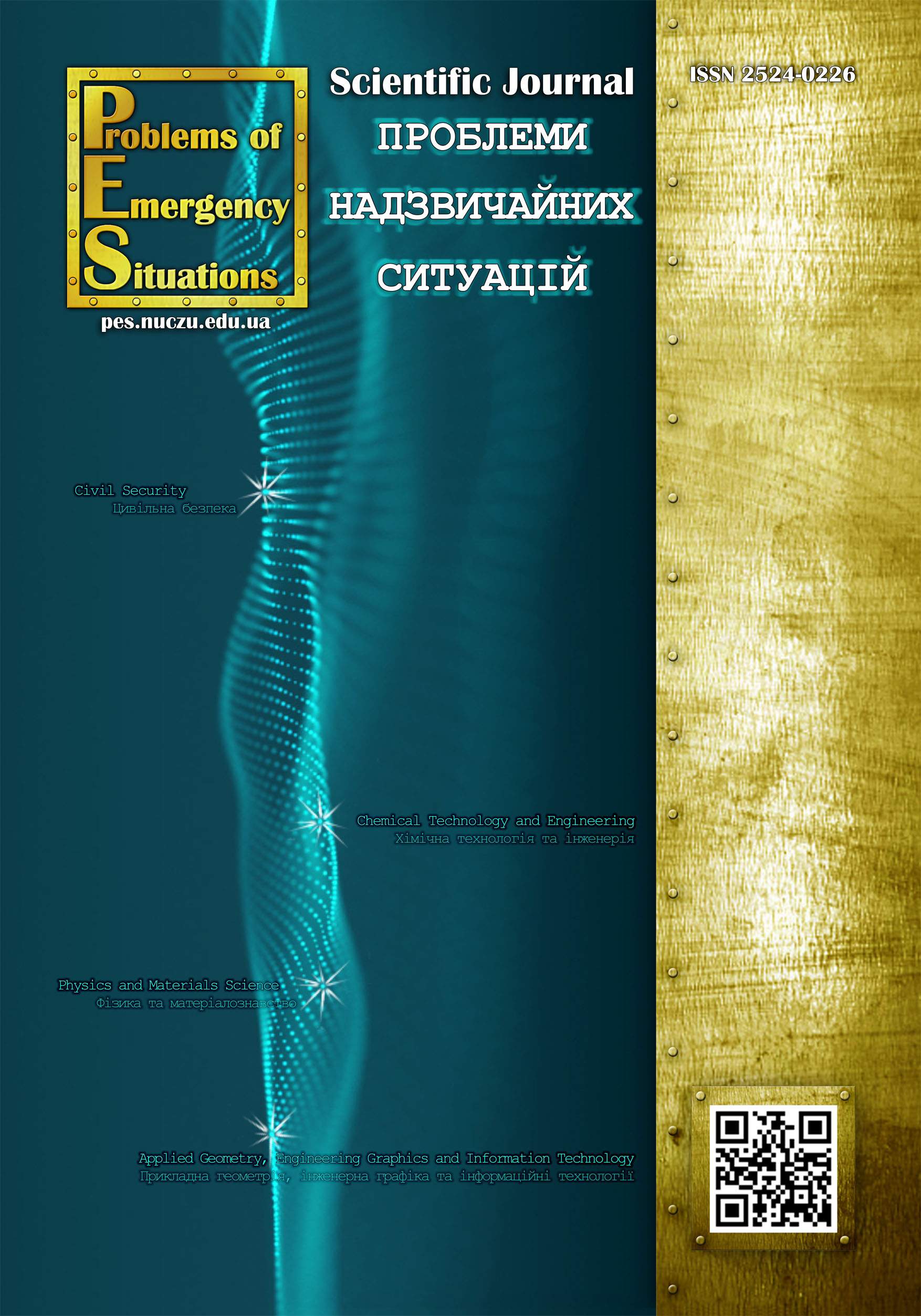Using fire extinguishing experience in the metallurgical coke wet quenching technology
Tregubov Dmytro
National University of Civil Protection of Ukraine
https://orcid.org/0000-0003-1821-822X
Trefilova Larisa
National University of Civil Protection of Ukraine
http://orcid.org/0000-0001-8939-6491
Danyk Olena
National University of Civil Protection of Ukraine
http://orcid.org/0009-0003-6849-3403
Rusenko Kateryna
National University of Civil Protection of Ukraine
http://orcid.org/0009-0009-4866-6032
Mazurov Volodymyr
National University of Civil Protection of Ukraine
http://orcid.org/0009-0009-0415-7834
DOI: https://doi.org/10.52363/2524-0226-2025-41-8
Keywords: metallurgical coke, heterogeneous combustion, wet quenching, wastewater, pulse spraying, disposal
Аnnotation
The metallurgical coke wet quenching technology was improved. An efficiency comparison, cost-effectiveness and environmental friendliness of coke cooling processes after removal from the furnace using wet and dry methods was carried out. These processes similarity to water fire extinguishing and fire quenching with non-flammable gases was analyzed. Attention is focused on wet quenching advantages and disadvantages and this technology improving feasibility. It is argued that coke single-stage quenching has significant thermal stresses in the lump due to a significant temperature excess in the lump middle over the surface temperature, which at the same time reduces the wastewater impurities neutralization efficiency on the coke surface. The theoretical possibility of the wastewater utilization efficiency increasing using wet quenching, reducing water consumption, improving the coke quality as an important blast furnace process component, and reducing the toxic gas contamination area near the quenching tower is shown. It was established that this issues set can be solved by the water supply phasing selecting for quenching in a pulsed mode, which can ensure the coke lump cooling process uniformity. The water cooling capacity theoretical value of the under conditions of the coke standard single-stage wet quenching and under this ability full use conditions was calculated. It was shown that the using water efficiency as a cooling agent increases if it is completely evaporated and the steam is heated to the coke temperature. According to the assessment, the supply time and water consumption are reduced by 7.5 times when its cooling ability is fully utilized. It is proposed to carry out wet quenching in 3 stages: for 1 min – with concentrated wastewater, for 2 min – with diluted wastewater, for 3 min. – with technical water. The intervals system of water supply pulse mode for the coke cooling with a “supply-pause” scheme with a total quenching time of 219 s was developed, of which the total water supply time is 19 s.
References
1 Myroshnychenko, I. V., Fatenko, S. V., Miroshnychenko, D. V., Shulʹha, I. V. (2022). Rozshyrennya syrovynnoyi bazy koksuvannya ta polipshennya vlastyvostey koksu yak domennoho palyva: monohrafiya. Kharkiv–Ternopilʹ: Krok, 254. Available at: https://repository.kpi.kharkov.ua/items/6b3cab3a-0be1-4c1e-81f3-6024265bf54e
- Trehubov, D., Dadashov, I., Minsʹka, N., Hapon, Yu. Chyrkina-Kharlamova, M. (2024). Fizyko-khimichni osnovy rozvytku ta hasinnya pozhezh horyuchykh ridyn. Kh.: NUTSZ Ukrayiny, 216. Available at: http://repositsc.nuczu.edu.ua/handle/123456789/
19111 - Shulga, I. V., Miroshnichenko, I. V., Ryshchenko, I. M., Miroshnichenko, D. V. (2019). Moisture content of wet-quenched coke, Coke and Chemistry, 62(9), 402–407. doi: 10.3103/S1068364X19090084
- Tregubov, D., Tarakhno, O., Sharshanov, A. (2015). Forecast efficiency phlegmatizing combustible systems by oxygen-containing mixes, Problems of Fire Safety, 37, 228–234. Available at: http://repositsc.nuczu.edu.ua/handle/123456789/3196
- Fidchunov, A. L., Vasil’ev, Yu. S., Fidchunov, L. N., Shulga, I. V. (2016). On coke burnout and productivity of the USTK, Coal Chemical Journal, 2, 8–12. Available at: https://www.ukhin.org.ua/images/magazine/2016/2_2016/Journal1-2_2016-2.pdf
- Kwiecińska, A., Figa, J., Stelmach, S. (2016). The Use of Phenolic Wastewater in Coke Production. Polish Journal of Environmental Studies, 25(2), 465‒470. doi: 10.15244/pjoes/60725
- Kolomiichenko, A. I., Zolotarev, I. V., Mostovoi, O. N., Kasyun, S. I., Toryanik, E. I. (2017). Producing Coke of Improved Quality, Coke and Chemistry, 60, 424‒428. doi: 10.3103/S1068364X17110035
- Karpenko, O., Lazarenko, O., Lazarenko, T., Nikolaychuk, Ju. (2012). Conception of improvement of resource-saving technologies and technological equipment is for production of coke with the set properties, Energy saving. Power engineering. Energy audit, 7(101), 71‒76. Available at: http://eee.khpi.edu.ua/article/view/20409
- Strakhov, V., Kaliakparov, A., Panfilov, V., Imanbaev, S., Aubakirov, A. (2022). Coke Quality in Medium-Temperature Coking of Fractionated Long-Flame Coal, Coke and Chemistry, 65, 316–334. doi: 10.3103/S1068364X22080051
- Sklyar, I., Pyrohov, O. (2021). Deyaki osoblyvosti vyznachennya pobichnykh zbytkiv vid pozhezh. Mizhnarodna NPK molodykh vchenykh, kursantiv ta studentiv «Problemy ta perspektyvy rozvytku systemy bezpeky zhyttyediyalʹnosti». L.: LDU BZHD, 108–109. Available at: http://repositsc.nuczu.edu.ua/handle/123456789/14924
- Trehubov, D. H., Ponomarenko, R. V., Slepuzhnikov, Ye. D., Chyrkina,M. A. (2022). Rezhymy zneshkodzhennya stichnykh vod mikroduhovym rozryadom u systemi z obʺyemnym elektrodom. Podolannya ekolohichnykh ryzykiv ta zahroz dlya dovkillya v umovakh nadzvychaynykh sytuatsiy: monohrafiya. Poltava–Lʹviv–Dnipro: Serednyak T. K., 509–519. doi: 10.23939/monograph2022
- Delort, N., Meziane, I., Herbinet, O., Carstensen, H.-H., Battin-Leclerc, F. (2024). Experimental and modelling study of phenol combustion and oxidation, Proceedings of the Combustion Institute, 40, 105247. doi: 10.1016/j.proci.2024.105247
- Maffei, L., Pelucchi, M., Faravellia, T., Cavallotti, C. (2020). Theoretical study of sensitive reactions in phenol decomposition, Reaction Chemistry & Engineering, 3, 452–472. doi: 10.1039/C9RE00418A
- Trehubov, D. H., Minsʹka, N. V., Hapon, Yu. K., Tarakhno, O. V. (2024). Teoriya protsesiv horinnya, vybukhu ta pozhezhohasinnya. Kharkiv: NUTSZ Ukrayiny. Available at: http://repositsc.nuczu.edu.ua/handle/123456789/20224
- Zhun, L., Rongwei, B., Jiaming, Z., Yang, Zh. (2019). Numerical investigation on fire-extinguishing performance using pulsed water mist in open and confined spaces, Case Studies in Thermal Engineering, 13, 100402. doi: 10.1016/j.csite.2019.100402
- PubChem. Compound summary. Available at: https://pubchem.ncbi.
nlm.nih.gov/ - Glassman, I., Yetter, R., Glumac, N. (2014). Combustion. London: Elsevier. doi:10.1016/C2011-0-05402-9
- Khrystych, V. V., Malyarov, М. V., Bondarenko, S. M. (2016). Modern how to improve firefighting mist water. Problems of Fire Safety, 40, 201–205. Available at: http://repositsc.nuczu.edu.ua/handle/123456789/2198














